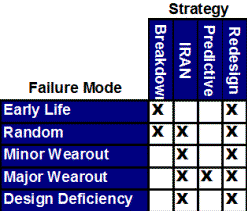Maintenance Strategies
How Failure Mode Determines Strategy
 Several strategies or approaches are
available for improving the maintenance or breakdown performance of equipment. These are:
Several strategies or approaches are
available for improving the maintenance or breakdown performance of equipment. These are:
- Breakdown
- IRAN (Inspect & Repair As Necessary)
- Predictive
- Redesign

Table 2 Failure Modes & Maintenance Strategies
This table shows which strategies are effective at improving performance for each failure mode.
The best strategy for a particular machine or situation depends on the failure mode being experienced. For example, IRAN is seldom effective for preventing early life failures. These rarely give warning and there is no history to draw upon. Early life failures must be addressed in the original design and also in the original manufacture and test of the equipment. Once in service, about all you can do is wait until something breaks. This is why one of the "Pillars of TPM" is new equipment management.
Table 2 (right) shows which strategies usually apply to each failure mode an Table 3 (below) summarizes these strategies. Note that the redesign (design) strategy applies to all failure modes. Throughout the equipment life, proper design and then redesign is the most critical element for ensuring equipment performance. Yet capital equipment is often purchased using price as the primary decision factor.
Table 3 Maintenance Strategies
| Description | Examples | Usage |
| Breakdown Maintenance | ||
| Do nothing until equipment fails When failure occurs, repair as required. | ■ Replace jib hoist when hoist fails. ■ Overhaul in shop and use as spare ■ Replace nut runners when they fail ■ Replace light switches when they fail |
■ Breakdown cost is low ■ Components are cheap. ■ Replacement is easy ■ inspection is difficult ■ Failures do not cascade. |
| Inspect & Repair As Necessary (IRAN) | ||
| Inspect on schedule to detect imminent failure-Replace or repair before failure- Often combined with scheduled service such as lubrication- | ■ Inspect for visible cracks while lubricating ■ Inspect V-belts for cracks or fraying ■ Check air pressure in tires & tread for wear. ■ Visual inspect contacts on motor starter and replace when pitted. |
■ Inspection is easy. ■ Incipient failure is evident before actual failure. ■ Wearout highly variable. |
| Predictive Maintenance | ||
| Monitor equipment and components with long-range predictive techniques such as vibration analysis, infrared or known wearout life. Replace prior to failure. | ■ Overhaul aircraft engine after 5000 hours. ■ Replace filters every three months. ■ Group re-lamp office areas. ■ Monitor bearing vibration signature and replace as indicated. ■ Monitor infrared signature of electric motor and replace as indicated. |
■ Failure is catastrophic. ■ Wearout is predictable. ■ Replacement is inexpensive |
| Equipment Redesign | ||
| Equipment is redesigned with more robust components, to increase reliability, make inspection easier or make replacement easier. | ■ Mount electrical cabinets on overhead crane with vibration isolators. ■ Motor starter size increased. ■ Pendant controls on overhead crane are redesigned with quick-connectors and shock mounts to reduce failures & make replacement quick. |
■ MTTR & failure cost is high. ■ Failure Rate is high. ■ Inspection is difficult |
■ ■ ■ ■ ■ ■ ■


